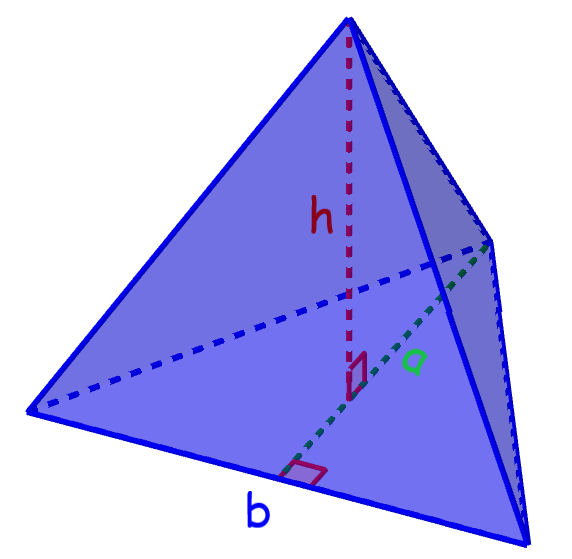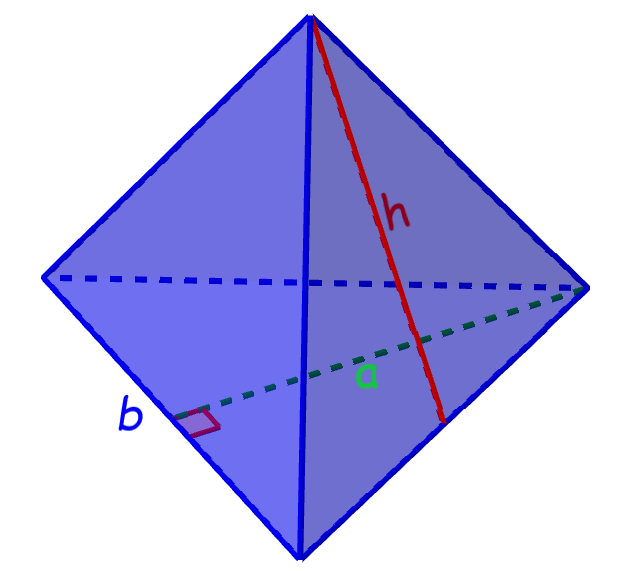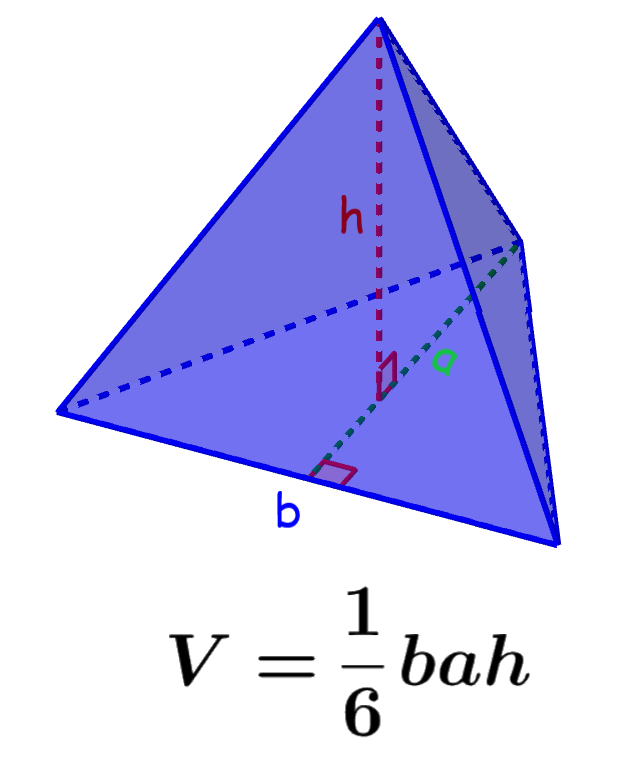The volume of a triangular pyramid is calculated by multiplying the area of the base by the height of the pyramid and dividing by 3. On the other hand, the surface area of a triangular pyramid is equal to the sum of the areas of all the faces of the pyramid.
Here, we will look at the formulas that we can use to find the volume and the area of triangular pyramids. Also, we will explore some practice problems where we will apply these formulas.
How to find the volume of a triangular prism
The volume of any pyramid is equal to the area of the base times the height of the pyramid divided by three. Therefore, the following is the formula for the volume of a pyramid:
$latex \text{Volume} = \frac{1}{3}\times \text{Area base}\times \text{Height}$
In turn, we know that the base of a triangular pyramid is a triangle and the area of any triangle is found by multiplying the length of its base by its height and dividing by two. Therefore, we have:
$latex V=\frac{1}{3}(\frac{1}{2}ba)(h)$
| $latex V=\frac{1}{6}bah$ |
where b is the length of the base of the triangle, a is the length of the height of the triangle, and h is the height of the pyramid.

How to find the surface area of a triangular pyramid
We can find the surface area of triangular pyramids by adding the areas of all the faces of the pyramid. A pyramid with a triangular base has a total of four faces, and these four faces are triangular. That means we have to use the formula for the area of a triangle to calculate the areas of the faces.
Recall that the area of any triangle is found by multiplying half the length of its base by the length of its height. Therefore, we need to know the length of the base and the height of each of the triangular faces.
Let’s consider the following diagram:

If the base is an equilateral triangle, which is generally the case, the length of one of these sides is equal to the base of all the faces. Also, if the base is equilateral, the lateral faces have the same area.
Therefore, the area of the base is equal to $latex \frac{1}{2} ba$, where b is the length of the base and a is the length of the height of the base triangle.
On the other hand, the area of each lateral face is equal to $latex \frac{1}{2} bh$, where b is the length of the base and h is the slant height of a lateral face. Therefore, the surface area is equal to:
| $latex A_{S}=\frac{1}{2}ba+\frac{3}{2}bh$ |
Volume and area of a triangular pyramid – Examples with answers
EXAMPLE 1
A pyramid has a height of 5 m and a triangular base with a base of length 4 m and a height of 3 m. What is its volume?
Solution
We have the following information:
- Pyramid height, $latex h=5$
- Base of the triangle, $latex b=4$
- Height of the triangle, $latex a=3$
We use these values in the volume formula:
$latex V=\frac{1}{6}bah$
$latex V=\frac{1}{6}(4)(3)(5)$
$latex V=10$
The volume is equal to 10 m³.
EXAMPLE 2
What is the surface area of a pyramid that has a triangular base with sides of length 3 m and a height of 2.6 m and whose lateral faces have a slant height of 4 m?
Solution
We have the following lengths:
- Base, $latex b=3$
- Base height, $latex a=2.6$
- Lateral face height, $latex h=4$
Using the formula for the surface area with these lengths, we have:
$latex A_{S}=\frac{1}{2}ba+\frac{3}{2}bh$
$latex A_{S}=\frac{1}{2}(3)(2.6)+\frac{3}{2}(3)(4)$
$latex A_{S}=3.9+18$
$latex A_{S}=21.9$
The surface area is 21.9 m².
EXAMPLE 3
What is the volume of a pyramid that has a height of 8 m and a triangular base with a base of 5 m and a height of 6 m?
Solution
We have the following values:
- Pyramid height, $latex h=8$
- Base of the triangle, $latex b=5$
- Triangle height, $latex a=6$
Using this information in the volume formula, we have:
$latex V=\frac{1}{6}bah$
$latex V=\frac{1}{6}(5)(6)(8)$
$latex V=40$
The volume is equal to 40 m³.
EXAMPLE 4
A pyramid has a triangular base with sides of 4 m and a height of 3.5 m. If the slant height of its lateral faces is equal to 5 m, what is its surface area?
Solution
We have the following values:
- Base, $latex b=4$
- Base height, $latex a=3.5$
- Lateral face height, $latex h=5$
We use these values in the formula for surface area:
$latex A_{S}=\frac{1}{2}ba+\frac{3}{2}bh$
$latex A_{S}=\frac{1}{2}(4)(3.5)+\frac{3}{2}(4)(5)$
$latex A_{S}=7+30$
$latex A_{S}=37$
The surface area is 37 m².
EXAMPLE 5
A pyramid has a height of 11 m and a triangular base with a base of length 7 m and a height of 8 m. What is its volume?
Solution
From the question, we get the following values:
- Pyramid height, $latex h=11$
- Base of the triangle, $latex b=7$
- Triangle height, $latex a=8$
We use the volume formula with these values:
$latex V=\frac{1}{6}bah$
$latex V=\frac{1}{6}(7)(8)(11)$
$latex V=102.7$
The volume is equal to 102.7 m³.
EXAMPLE 6
A pyramid has a triangular base with sides of 6 m and a height of 5.2 m. If the slant height of its lateral faces is equal to 6 m, what is its surface area?
Solution
From the question, we have the following:
- Base, $latex b=6$
- Base height, $latex a=5.2$
- Lateral face height, $latex h=6$
We use these values in the formula for surface area:
$latex A_{S}=\frac{1}{2}ba+\frac{3}{2}bh$
$latex A_{S}=\frac{1}{2}(6)(5.2)+\frac{3}{2}(6)(6)$
$latex A_{S}=15.6+54$
$latex A_{S}=69.6$
The surface area is 69.6 m².
EXAMPLE 7
What is the volume of a pyramid with a height of 9 m and a triangular base of a base of 7 m and a height of 9 m?
Solution
We have the following values:
- Pyramid height, $latex h=9$
- Base of the triangle, $latex b=7$
- Height of the triangle, $latex a=7$
We substitute these values in the volume formula:
$latex V=\frac{1}{6}bah$
$latex V=\frac{1}{6}(7)(9)(9)$
$latex V=94.5$
The volume is equal to 94.5 m³.
EXAMPLE 8
What is the surface area of a pyramid that has a base with sides of length 7 m and height 6 m and lateral faces of slant height 10 m?
Solution
We have the following lengths:
- Base, $latex b=7$
- Base height, $latex a=6$
- Lateral face height, $latex h=10$
Substituting these values in the formula for surface area, we have
$latex A_{S}=\frac{1}{2}ba+\frac{3}{2}bh$
$latex A_{S}=\frac{1}{2}(7)(6)+\frac{3}{2}(6)(10)$
$latex A_{S}=21+90$
$latex A_{S}=111$
The surface area is 111 m².
Volume and area of a triangular pyramid – Practice problems


A pyramid has a base with sides of length 10 m and height 8.6 m. If the height of the pyramid is 12 m, what is its surface area?
Write the answer in the input box.
See also
Interested in learning more about triangular pyramids? Take a look at these pages:




